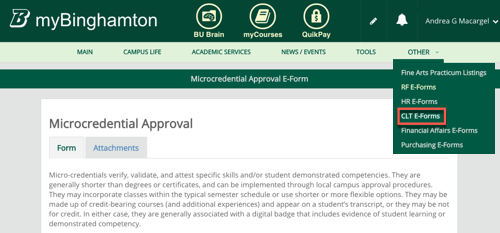updated November 18, 2021
Microcredentials offered by Binghamton University
Microcredentials verify, validate, and attest specific skills and/or student demonstrated
competencies. They are generally shorter than degrees or certificates, and can be
implemented through local campus approval procedures. They may incorporate classes
within the typical semester schedule or use shorter or more flexible options. They
may be made up of credit-bearing courses (and additional experiences) and appear on
a student’s transcript, or they may be not for credit. In either case, they are generally
associated with a digital badge that includes evidence of student learning or demonstrated
competency.
Binghamton microcredentials
Binghamton microcredentials have a clear purpose of preparing students for the workforce,
helping students stand out to employers, bridging to larger credentials, supporting
life-long learning opportunities for professionals, and enhancing professional skills
through continuing education. As defined by the National Association of Colleges and Employers (NACE), career readiness is the attainment and demonstration of requisite competencies that
broadly prepare college graduates for a successful transition into the workplace.
Each microcredential has a demonstrated relationship to at least one the NACE competencies:
- critical thinking/problem solving
- oral/written communications
- teamwork/collaboration
- digital technology
- leadership
- professionalism/work ethic
- career management
- global/intercultural fluency.
Types of Microcredentials
There are two types of microcredentials at Binghamton:
-
Credit-Bearing
Credit-bearing microcredentials consist of completion of coursework and may also require
additional experiences. Binghamton credit-bearing microcredentials must be greater than 4 credits but cannot
exceed 12 credits. They also must include two courses, at a minimum.
The microcredential will be transcripted. They will also be associated with digital
badges issued by Binghamton University through Credly which requires submission of evidence that the bearer has attained the learning objectives
of the microcredential.
-
Non-credit Bearing
Non-credit microcredentials are typically smaller learning opportunities in which
learners will earn digital badges issued by Binghamton University through Credly which requires submission of evidence that the bearer has attained the learning objectives
of the microcredential.
Approval Process
Both types of microcredentials go through approval process that involves faculty and
departments prior to submission to the Office of Microcredentials.
-
Credit-Bearing Approval Flow

For credit-bearing microcredentials, the approval process length depends on many committees
and therefore the time for approval varies.
The average time from initial submission to final approval is 170 days.
-
Non-credit Bearing Approval Flow
Department Chair/Director > Dean/Unit Head > Office of Microcredentials
One the OMC receives the proposal, the OMC will have an initial response back to the submitter within 2 weeks. However, there may be one or more
requests for resubmission, which may lengethen the overall approval process.
The average time from initial submission to final approval is 45 days.
Proposal Submission
There is a three step process to offer a new microcredential and digital badge.
- The Proposal Form to offer the microcredential.
- The badge information and metadata is collected for display on the Credly platform.
- Information on learners who will be issued a badge.
-
Step 1: Proposal Form
The Microcredential Proposal Form is available as Microsoft Word document.
Question 9
Proposals are frequently sent back due to an insufficient response to question 9.
Please consult the FAQs prior to submitting your proposal to ensure you are responding to this question at
a level of detail expected from the committee.
Submitting the Proposal From
To submit the proposal form and begin the approval process described above, visit CLT E-Forms on the my.binghamton.edu portal and follow the directions.

Check Proposal Approval Status
You can check the status of your submission in the myBinghamton portal by clicking
on the bell icon and My Workflows. Click on the name of workflow to see what step
the approval is on.

-
Step 2: Badge Information
Once the microcredential has been approved, Credly requires extensive information
about each badge before it can be issued.
Complete the Digital Badge Creation Form to supply the OMC with this information. You will need to download the form to complete
it. Do not use the preview mode in your browser.
You will be sent a sample badge to review before publishing.
-
Step 3: Recipient Information
Once you are ready to issue badges to recipients, you will be sent a spreadsheet to
complete with the recipient information, called a bulk issue template.
The bulk issue template has five required fields:
- Badge Template ID - the unique ID that represents the badge a candidate will be issued.
The OMC will provide this number to you after step 2 (above) is completed.
- Recipient Email
- First Name
- Last Name
- Issued at date
Download a sample file here.
There are many optional fields. Feel free to use these or not, but do not remove the
column headers.
Charging of fees for non-credit Microcredentials
The text below is shared for information purposes only. The Office of Microcredentials
does not approve fees for non-credit microcredential offerings. Please consult with
the Budget Office with any questions regarding fees.
For more information, visit University Fees.
Campus Authorized Fees
The Board of Trustees authorizes Binghamton University to establish certain fees without
SUNY approval. Fees that fall into this category include, but are not limited to:
residence hall room rates, board plan rates, orientation charges, library charges,
non-credit bearing instructional program fees, and service charges. Campus Units interested
in establishing or changing these types of fees should first consult with their area
financial representative and then with the Budget Office to assess feasibility, classification,
implementation timeline, and an action plan.


